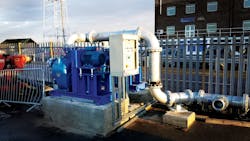Installing new pumps at the Stillingfleet Surface Water Pumping Station.
Whether it is the repair or refurbishment of a floodwater pumping station or the construction of a completely new one, it is essential to match the correct pump(s) to the application. Finding a pump supplier that can provide a variety of pump options, relevant engineering resources and a sound track record for working in this specialized sector, has to be a high priority. Opting for the most competitive estimate can be attractive, but it can be a bad decision should problems arise later on.
Keys to Pump Projects
In an existing pumping station where pumps are showing signs of wear or poor performance, their replacement may at first seem the best option, particularly if they are well beyond their design life. However, this can be costly and may not always be the best long term solution. Pump experts should be brought in to conduct a detailed survey of the existing infrastructure and condition of the pump(s) before any decision is taken to either replace or refurbish the problem pumps.
In the U.K., pump distributor AxFlow has invested engineering resources into the maintenance, repair and design of floodwater pumping stations. Part of the pan-European AxFlow Group, the company has developed an operation specializing in floodwater pumping stations that provides services to river and drainage authorities, operators of industrial parks, and owners of ports and harbors. This encompasses new builds and complete refurbishment projects.
“Over several years, we have built up a wealth of experience and expertise, which we believe provides a sound blueprint that covers all engineering services and eventualities,” said Mark Redgrove, AxFlow’s technical services manager. “At the outset of a project, it is essential that communications between the customer and supplier [be] kept open at all times. Both parties need to know who is involved, what their job [or] role is, and that regular updates on progress are scheduled. Projects only run smoothly when there is a plan of action, complete with dates for actions to be completed.”
Access to a comprehensive range of pump technologies and the ability to present the customer with a number of options in line with budgets are major advantages when new pumps are required. Resources and qualified engineering personnel who undertake site work, install and commission pumps, and reconfigure pump stations also are necessary.
“Within our resources, we have the necessary skill sets in hydraulics, civil engineering and logistics,” Redgrove said. “For many projects, it is necessary [to] have readily available resources in terms of cranes and transport. Once we have conducted a full site survey that includes a detailed examination of the pumps and the causes of wear or damage, we can then present the customer with a project document that sets out all the works that need to be undertaken together with full costings.”
The two new pumps were installed directly above the discharge pit at the Port of Immingham.
Case Studies
Such a scenario is illustrated by two different projects undertaken in the past 18 months. Working on behalf of the Ouse & Derwent Internal Drainage Board, AxFlow installed two new submersible Bedford pumps at the Stillingfleet Surface Water Pumping Station. Built in the early 1990s, the pumping station lifts surface water that could no longer drain by gravity into the nearby stream.
High moisture readings were being recorded within the pump linings containing the electrical equipment, causing an operational concern.
“The pumping station was equipped with two large 800-mm rising main storm and two 600-mm rising main dry weather pumps,” Redgrove said. The pumps needed to be removed while maintaining the station’s pumping capacity. When the existing pumps were removed, two submersible Bedford pumps replaced them.
“At first, it appeared to be a straightforward job to remove and replace the pumps using scaffolding,” Redgrove said. “However, installing scaffolding in the wet well was not practical because of space limitations, plus the wet well was not totally sealed from the flows. The rising water levels required one pump running on and off to keep the level down.”
An engineer in a man-riding basket was suspended into the wet well to remove the pumps. The removal and replacement project took three days.
For many industrial sites that contain large areas of open space, surface water buildup can prove to be a problem. The Port of Immingham is the U.K.’s largest port by annual tonnage. Surface water always has been removed from the 1,230-acre site via by a tidal flap (valve) that drained the water into the Humber Estuary. However, as a result of recurrent blockages, port engineers were keen to find a permanent solution to the problem.
In mid-2015, AxFlow proposed building a surface-mounted pumping station that would pump the water into the dock.
“The existing drainage system consisted of a series of underground chambers that collected the water, which then drained into a main discharge pit on the lock side of the port,” Redgrove said. “From there the water was discharged through the tidal flap located on a mud bank in the estuary. However, this regularly silted up, with clearing away the silt and mud having to be undertaken manually by divers.”
The new pumping station was positioned over the discharge pit and comprised two self-priming pumps, galvanized Mild Steel pipework, heated jackets for cold weather protection and a control panel with pulsar ultrasonic level control.
A surface-mounted self-priming pump was selected for the 1-sq-meter discharge pit. This pump fit in the small pit better than a submersible pump and offered easier maintenance. Vortex pumps were selected because of the grit and solids found in the dock runoff. These pumps are not affected by solids.

